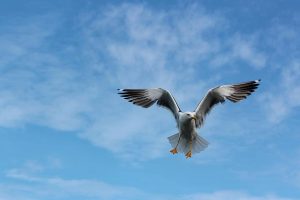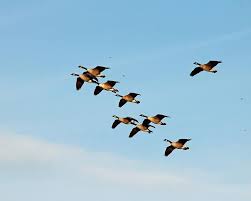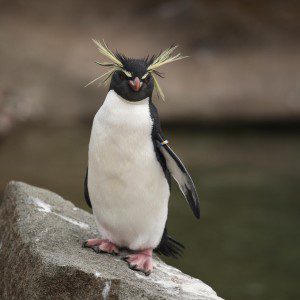Flight probably evolved from gliding. As feathers became elongated, perhaps for display, they became more suitable to support flight. See Wikipedia for detailed discussion.See a New Theory of Bird Flight and Theory of Bird Flight Linked to Parental Care. Most adaptations a bird has for flight are based on two basic factors- increased power and decreased weight. To have both the power and the lightness needed to fly, there have been a number of structural modifications in both the muscular and skeletal system:

|
light, strong, pneumatic bones; internal struts
|
uncinate processes to strengthen rib cage
|
|
loss and fusion of bones in hands, feet, pelvis and vertebral column
|
keeled sternum for muscle attachment and furcula for support
|
|
distribution of muscles for appropriate center of gravity
|
wings moved forward over the center of the body
|
|
wings increased in length to support more feathers
|
wing became extended in a flat plane
|
Generally, a bird’s skeleton is rigid and solid with the exception being the flexible neck – necessary because the bill is the only structure most birds use to manipulate objects.
Greek mythology had people with wings flying around, but the first reference in the literature to aerodynamic principles was in the 13th century A.D. when Wayland the Smith made a suit for his brother out of swan feathers and told him to jump off a hill, fly downwind, and land into the wind.
Forces of Flight
 There are four forces that act on a flying machine in flight, whether bird, bat, insect, or airplane: lift, thrust, drag, and gravity. Thrust must equal drag and lift must equal gravity in straight and level flight. The x-section of a wing (airfoil) resembles a teardrop shape. When the leading edge of a streamlined wing cleaves the air, it pushes the air both up and down so that the amount of air passing above and below the wing is the same. But if the contours of the wing are unequal, the air pressure against them will be unequal because one airstream must travel faster over one surface of the wing than the other. Because the air molecules travel faster and over a longer distance, there is less pressure ( Bernoulli’s Principle.) Thus the wing moves up into the area of lesser pressure (LIFT).
There are four forces that act on a flying machine in flight, whether bird, bat, insect, or airplane: lift, thrust, drag, and gravity. Thrust must equal drag and lift must equal gravity in straight and level flight. The x-section of a wing (airfoil) resembles a teardrop shape. When the leading edge of a streamlined wing cleaves the air, it pushes the air both up and down so that the amount of air passing above and below the wing is the same. But if the contours of the wing are unequal, the air pressure against them will be unequal because one airstream must travel faster over one surface of the wing than the other. Because the air molecules travel faster and over a longer distance, there is less pressure ( Bernoulli’s Principle.) Thus the wing moves up into the area of lesser pressure (LIFT).
But as air passes over the wing, friction is generated; the effect of this friction is to slow the wing and is called DRAG. If the wing is tilted upward (increased angle of attack), the pressure on the upper part of the wing is reduced even further and lift increases; but so does drag. As the angle of attack continues to increase, more lift is produced – up to about 15-18 degrees, it is so steep that air cannot flow smoothly over the top of the wing and lift decreases until a stall (loss of lift) occurs. The more thrust there is, the higher the angle of attack can be without stalling. That’s why jets and rockets can go straight up and why their wings are small – because they use the vertical component of thrust rather than lift to gain altitude. To reduce turbulence, wing slots can be used. These slots are on some airplanes as slats or double wings as on biplanes. On a bird, a special small group of feathers attached to the thumb (1st digit), the alula, rests on the anterior wing surface and can be raised so that there is a gap between it and the rest of the wing. At higher angles of attack, the pressure above the alula drops and it is automatically sucked up to make the slot. Mallards, for example, use the alula to take off at high angles of attack – 60 degrees or so. See photos of birds in flight.
For a more complex physical explanation of the biomechanics of bird flight, click here.
Larger birds are disproportionately heavier than smaller birds and thus have to have disproportionately larger wings to support their weight. There is an upper limit to a flying bird’s size because as the bird gets heavier and the wings larger to carry that weight, the wings also add weight. A four gram kinglet has wings which account for 9% of its weight; the Griffon Vulture, weighing seven kilograms, has wings that total 25% of its weight. There’s also the problem of inertia due to a long fulcrum. So the largest flying bird – the Wandering Albatross- with a four meter wingspan- probably represents the largest birds that ever flew. See this explanation of Wing Loading.
How does a bird develop thrust? Actually, the wings function as propellers. During the downwards wing beat the primary wing feathers stand out almost at right angles to the rest of the wing and to the line of flight. The primary feathers are twisted for only a split second, but their twisting is what gives the propeller motion. In an airplane propeller, rotation is around a single point. In a bird wing which oscillates up and down, the feathers must continually change position to produce the thrust. In slow flight only the tips of the wings act as propellers; in fast flight or on takeoff, the entire outer wing may go through the motion (you can hear pigeons slap wings together on takeoff). In leisurely flight the wingtip movement is more vertical. The secondary feathers on the inner part of the wing, attached to the ulna, provide lift. See video.
We often admire soaring birds; soaring is essentially coasting downhill on a current of air. Birds stay aloft by riding rising air currents. Obstruction currents are updrafts caused by the deflection of a horizontal wind upward by a cliff, hillside, ocean wave, etc. Convection currents (thermals) are updrafts of warm air caused by the sun heating the ground; the ground reradiates the heat which warms the air above it, causing it to rise. (When you see vultures soaring, it doesn’t mean there’s something dead, only that they’re soaring on air currents.) Over the ocean, when the breezes are under 14kph in the fall, the water, being warmer than the air, produces vertical currents of rising warm air on which the birds ride and they soar around in circles. As the wind exceeds 14kph, these vertical columns of air are blown horizontal and birds soar in a straight line. They will soar into the wind to gain altitude and then lose altitude to gain distance. The birds control soaring/gliding speeds and altitude by spreading or pulling in their wings to increase or reduce lift.
The power for control of the wings comes from the pectoralis muscle which originates on the ventral part of the chest and collar bone and inserts on the ventral side of the arm. It serves to depress the wing.  The supracoracoideus originates dorsal to the pectoralis; both of these muscles constitute the breast of the bird. A few birds, most obviously the hummingbird, can hover and fly backward. Hovering requires a drastic modification of the wing; the wing is almost all hand and the entire wing serves as a propeller. There is very little lift, but a lot of thrust produced because thrust is produced on both the fore and backstroke of the wings.
The supracoracoideus originates dorsal to the pectoralis; both of these muscles constitute the breast of the bird. A few birds, most obviously the hummingbird, can hover and fly backward. Hovering requires a drastic modification of the wing; the wing is almost all hand and the entire wing serves as a propeller. There is very little lift, but a lot of thrust produced because thrust is produced on both the fore and backstroke of the wings.
Landing is more difficult than taking off and flying and because of the potential shock involved, the process of landing is probably one reason for the fusion of bones in birds. Some birds land vertically, but most land at an angle against the wind to slow down, using their spread wings, tail and alula. Some run across the ground to dissipate momentum. Woodpeckers and other that land on the sides of trees fly below their intended landing site and land in an upswing. A good deal of misinformation has been uttered about the speed of bird’s flight.
Flight Speed
Flight speed is dependent upon the bird, the weather, the wind, etc. In general, the flight speed of small passerines varies from 15 to 50 mph. Ducks will cruise around 30 mph but can reach 60. A Peregrine Falcon, chased by an airplane (unusual circumstances) – top speed ever recorded at 145 mph. American Kestrels fly at about 25 mph, Canada Geese 30, Great Blue Heron 20, Crows at 25-30, etc.
Many birds fly in flocks. There can be flight aggregations, whereby birds fly around more or less together but are rarely coordinated – e.g. gull or terns feeding on a school of fish. A true flock is one in which the birds are more or less coordinated in one or more flight parameters: turning, spacing, velocity, flight direction, etc. May be very coordinated – e.g. shore birds, or very loose, e.g. sparrows, robins.
Why do birds flock? There are a number of social factors – reproduction, protection from predators, communication, navigation, etc. But let’s look only at aerodynamic factors for the time being. One theory is that in coordinated flight flocks such as those of waterfowl, there’s an aerodynamic advantage to flying behind and to the side of another bird to take advantage of its wingtip vortices. Logical, and there is some data But if there were an aerodynamic advantage to flocking, why don’t more birds do it? Very hard to study this kind of behavior. One theory of flight formation.
Under Water
Penguins, dippers, murres, puffins, and other related forms propel themselves underwater with their wings or with both their wings and feet. The most completely water-adapted birds are the flightless penguins. The wing bones are flattened and there is little movement at the elbow so the wing acts like a flipper.
Flightlessness
 A number of birds are flightless, most of which are island forms: many island rails; Giant Pied-billed Grebe of the Andes; flightless cormorant of the Galapagos; steamer duck and brown teal of South America; great Auk (extinct); kagu- N.Z. parrot; ratites: kiwi, ostrich, moa (extinct), cassowary, emu, rhea.
A number of birds are flightless, most of which are island forms: many island rails; Giant Pied-billed Grebe of the Andes; flightless cormorant of the Galapagos; steamer duck and brown teal of South America; great Auk (extinct); kagu- N.Z. parrot; ratites: kiwi, ostrich, moa (extinct), cassowary, emu, rhea.
Links
The Secrets of Flight
The Physics of Flight
Gliding and Parachuting
The Origins of Flight
The Evolution of Flight
What limits the altitude at which a bird can sustain itself, lose of lift due to the air density or loss of respiration, also due to air density? I am thinking of the famous Joseph Wright painting of “An experiment on a bired in the air pump”. His written description of what happens as the air is withdrawn, appears to say that the respiration will fail before the lift fails. Another way to ask the question is if we put a weightless source of oxygen on a bird to feed its lungs, would the altitude at which it would fall be greater or less than the limiting altitude without the oxygen source? This has been bothering me since I saw the painting in the National Gallery in London in 2019.
Thanks in advance for your response.
Well, the painting depicts a cruel experiment in which a bird is put in a vacuum chamber and all the air pumped out. Any bird would die quickly in that circumstance. As far as free-flying birds and altitude, it greatly depends on the species of the bird. Bar-headed Geese regularly fly over the Himalayas, but they are made for flight and their hemoglobin holds way more oxygen than other birds (or humans). Even if a bird had an unlimited source of oxygen, different species would have their altitude limits because of the structure of their wings and the energy required to flap the wings. A goose, shorebird, or swallow could fly quite high if oxygen were not a factor, but chickadees, woodpeckers, finches, and lots of others would fail at a lot lower attitude. Put another way, a goose would be able to travel much farther than a chickadee or woodpecker even at lower altitudes. It costs chickadees and woodpeckers a lot more energy to fly at any elevation than geese or swallows. Make sense?
Pingback: Pelican power (“Lake Monger 01.01.2022” series finale) – Pelican Yoga
Today is extremely windy. Our resident red tailed hawk is having a good time in it but I notice it is flying with legs fully extended. Does this give it better steering capability? I believe it’s not hunting.
I presume you mean the legs are hanging down. Probably gives the bird a bit more stability as that lowers the center of gravity and adds drag.
canr water spray be used to scare te birds disturbing the flight?